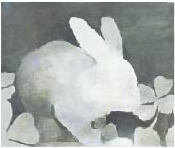
Luc Tuymans is considered one of the most significant and influential contemporary painters working today. He is one of the key figures of a new generation of figurative painters who have continued to paint during a time when many believed the medium had lost its relevance. In the context of the new information age, many artists felt that painting was a deeply conservative form of expression which did not match the heterogeneous nature of contemporary experience. Tuymans' work specifically addresses the challenge of the inadequacy and 'belatedness', as he puts it, of painting.
Tuymans was born in Antwerp, Belgium in 1958 and began to study fine art in 1976. He concentrated on painting but in the early 1980s he lost faith in the medium and gave up for two years. During this time he worked as a film-maker, and when he returned to painting in the mid-1980s, he introduced new techniques such as cropping, close-ups, framing and sequencing, which remain key elements of his work today.
Tuymans' work is a vast repository of data, drawn from photography, television and film, combining a range of different styles and subject matter. His subjects range from major historical events, such as the Holocaust or the politics of the Belgian Congo, to the inconsequential and banal - wallpaper patterns, Christmas decorations, everyday objects There are also paintings which express abstract emotional states, titled 'Embitterment' or 'Insomnia', which imply existential or philosophical responses to the human condition.
Tuymans' range of imagery deliberately resists categorisation. Events and ideas are not expressed explicitly, but implied through subtle hints and allusions, creating an ambiguous collage of disconnected fragments and details. Tuymans has extended this approach in the exhibition hang at Tate Modern. He has chosen to present individual paintings from various bodies of work, bringing together disparate images from different points in his career. This approach signals Tuymans' belief that representation can only be partial and subjective, and meaning must be pieced together, like memories, through isolated fragments.
**The large majority of his pieces are recreations on canvas of images already "recorded" in photographs and magazines from our everyday world. Tuymans' works take a stance that everything has already been painted, so reproduction is the only route forward. They are formed from extremely simplified scenes, drawn to shut out and exclude all traces of psychological description. Their topics are things like unoccupied rooms, a small child's torso without the limbs, or a human figure drawn as an object. Something in the surface of these works feels desolate, sometimes capturing our dull sense of anxiety, or sometimes, under the cool gaze of the artist, depicting with emotional detachment compelling aspects of history and politics that involve each and every one of us. They would penetrate deeply into our subconscious minds to leave dramatic impressions and unforgettable images.
Book about Luc Tuymans:
Reviewer: A reader
This book on Luc Tuymans is an excellent introduction to the strange world of this internationally reknowned Belgian Painter. What is it that stirs up the bizarre fascination of cognoscenti for this artist? At the very least, it is attributable to the deeply psychological expression that this artist conjures from his sometimes murky palatte, as well as his subject matter. He addresses these ideas in relation to living as an artist in this modern world and a Freudian psychoanalysis of history that seems all to prevalent in this information age; including, everything from the New York art world as evidenced in his painting "Heritage", which alludes to Jasper Johns flag painting and the Holocaust in paintings like "Our New Quarters". This artist also takes these issues to subjects like the body, which through his investigation and isolation of its various parts he formulates the queerness that follows a banal rendition of the functions of that space. In addtion, as a psychoanalytical historian this artist attempts to fuse the mundanity of the conscious world with the fanatsy of the world of dream, which always seems to be off center, and could be related to the work of Alex Katz and Robert Gober. At any rate, this book provides an excellent insight into the world created by Luc Tuymans, and comes highly recommneded by art lovers and aficianados alike.
***
Keyword Links: Luc Tuymans images , Guide to pictures of works by Luc Tuymans in art museum sites and image archives worldwide , Other Artist focused on in Art Talk (our Art Talk Index)
No comments:
Post a Comment